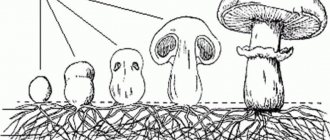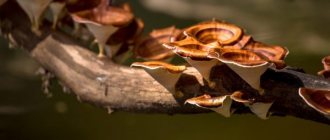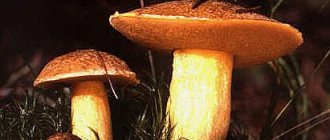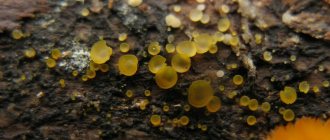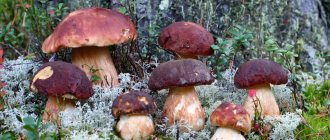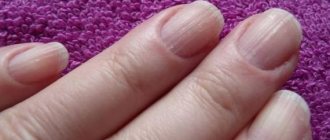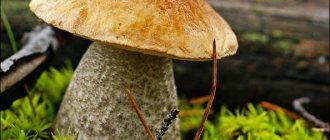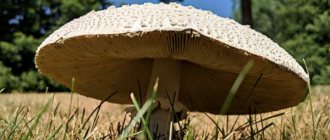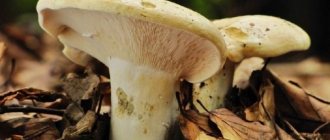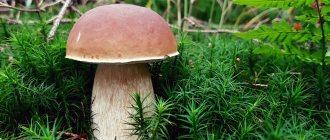Mushrooms
0
1341
Article rating
Kira Stoletova
Mushrooms are a unique kingdom of creatures that combine characteristics found in plants and animals. They reproduce using microscopic cells called spores. One mushroom can contain up to 40 billion of these microscopic particles. However, fungal spores do not always look the same.
Features of fungal spores
general information
A fungal spore is a transparent, white or pigmented reproductive structure that is formed during the process of asexual or sexual reproduction. Its structure is predominantly unicellular. Fungal “seeds” are found in groups, but a single spore develops independently of the others in that group.
The size of the fungal spore is so small (1-100 microns) that it can only be examined with a microscope.
Structure
Based on their structure and description of their appearance, mobile and immobile spores are conventionally divided into separate groups.
- Motile or zoospores: they look like lumps of protoplasm without a shell. A feature of their structure is the presence of flagella, with the help of which they move in a liquid environment and on a solid surface. Zoospores are more often present in aquatic lower fungi and differ in shape, location and number of flagella.
- Fixed: equipped with a dense shell, they do not have organs of movement. Their group is more diverse in shape, features, structure and other characteristics: with rays, in the form of a spiral or curls, in the shape of a ball, ellipse, thread or needle, with and without partitions, consisting of a single cell and multicellular.
In most cases, immobile spores have a dense pigmented shell, represented by 2 layers:
- exosporium (external): colored, sometimes covered with tubercles, warts, spines or bristles;
- endosporium (internal): colorless or white.
The internal space of the spores contains protoplasm, in which, as they develop, vacuoles appear, filled with cell sap. It also contains nutrients - glycogen reserves, carbohydrates, fats.
The number of nuclei varies between species. Thus, in marsupial and basidiomycetes, they are often mononuclear, while in zygomycetes, multinucleate ones are vegetatively formed on the mycelium.
Location
Depending on the type, the spores are located in different organs of the fungi.
- Ascospore: Formed and developed in the ascus (bursa) in marsupial species. Such an organ makes it possible to distinguish ascomycetes, for example, morels and truffles, into a separate class. One bag usually serves as a place for the maturation and growth of up to 8 ascospores; in some species this number varies and ranges from 4 to 128. The method of arrangement is predominantly linear.
- Basidiospore: is the reproductive structure of basidiomycetes. Located in special thickened terminal cells - basidia. Basidial cells are formed in the hymenial layer of the fruiting body or directly on the mushroom mycelium, for example in porcini mushrooms, puffballs and Reishi polypores. Typically, one basidium contains 4 basidiospores, each having one nucleus. Under favorable conditions, they germinate to form fungal hyphae.
- Conidiospores or conidia: nonmotile, known as mitospores because. appear as a result of mitosis. They are haploid cells. By the way. From a genetic point of view, they are completely identical to the haploid parent cells. They differ from the usual ones in the way of formation, which occurs not in sporangia, but on the open surface of the mycelium. Characteristic of marsupials, basidial, imperfect species.
Differences from bacteria
Bacterial spores differ from fungal ones in purpose, they perform different functions and have different characteristics:
- Unlike fungal spores, the formation of which occurs in special organs or on the surface of the mycelium, in the upper part of the stalk or on the cap in large quantities, they have a different method of formation - they appear more often as one separate spore as a result of the cell losing moisture and falling into a state suspended animation;
- have a different meaning, because they are required not only for reproduction, but also for the ability of a bacterial microorganism to survive in unfavorable conditions for it;
- Another difference is increased resistance to environmental conditions. Unlike mushrooms, they are able to withstand critical temperature changes (below -100 °C and above +100 °C), and are resistant to radiation, antiseptics and aggressive chemicals.
Interesting Facts
Spore formation and mechanisms can be of particular interest:
- The spores of the fungus can be called “smart”, because their separation from the vegetative body occurs at the most appropriate time.
- The record holder for the formation of cells for reproduction is Langermannia gianta. It produces 7 trillion spores.
- The way fungal spores spread is interesting. These organisms are able to create air movement that promotes cell proliferation. The temperature of the cap decreases as a result of the evaporation of moisture, which allows a small air flow to form in the area of its edge. This flow is invisible to humans, but it lifts light spore cells by 8-10 cm.
- Fungal cells that are formed in a bag (basidium) must retain parental genes in order to reproduce. If this did not happen, the new fruiting bodies that sprout from them would be different in appearance. However, they retain all external similarities. The process of gene preservation is not surprising. However, in spore fungi the size of the cells intended for reproduction is small. Therefore, many are interested in how they retain information about the genotype. This is explained by the presence of a special molecule in which data is stored. During the “unpacking” of this molecule, a special mechanism is launched to obtain information. It also exists in pollen cells and sperm.
- Some spores that are in the bag (basidium) come out with an acceleration of 20 thousand units after they mature. In this case, an overload of 3 units in a person leads to his death, but for spores such overloads are quite safe. During the release, some microscopic cells reach speeds of 25 m/s.
- When taking air samples, fungal spores will be found in almost any room. In the air there are cells of several representatives of the fungal kingdom.
- Some activated spores, after maturation and release from the bag, are able to withstand high temperatures (80-90 ° C).
- Not only representatives of the fungal kingdom have spores, but also bacteria. However, they perform different functions. The difference is that spores for a fungus are a method of reproduction, while for bacteria the same cells serve as protection that allows them to survive in an unfavorable environment.
- Fungal spores are capable of penetrating the body of humans, animals and plants. They begin to develop inside another organism. When ingested by small animals and insects, they often cause death. Developing in a person, they provoke the appearance of health problems. Parasitizing plants, they feed on their juices, which leads to death. Only in some cases is the union of mushrooms and plants mutually beneficial. Most often this is mycorrhiza.
Treatment of a person often takes a long time due to the fact that it is extremely difficult to destroy all microscopic cells. The most dangerous organisms for humans are pathogenic organisms.
Education process
Spores are located in different parts of the mushroom
They develop by mitosis inside fungal spore containers (sporangia) by an endogenous method or at the ends of mycelial processes (conidiophores) by an exogenous method. Tubular and lamellar fungi form fungal spores on the walls of hymenophore plates and tubes.
- Ascospores: appear during the process of meiosis - reduction division of the cell nucleus, during which the number of chromosomes is reduced by 2 times. It occurs in germ cells and leads to the formation of gametes (sex cells). After subsequent cell division, an asca (bag) is formed, where there are 4 spore pairs.
- Basidiospores: are formed during the process of sexual sporulation, in which the nuclei of two cells fuse during fertilization. The result is the appearance of first a diploid (with a double set of chromosomes) nucleus, dividing meiotically, and then 4 basidiospores are formed from it.
- Conidiospores: are formed during asexual reproduction during the process of mitosis - indirect cell division (with preservation of the original number of chromosomes): by blastic method - in which spores are visible until they separate from the conidiogenic hyphae, by thallic method - in which a septum initially develops, and then a part separating from it turns into a dispute.
When to plant mushrooms in the country
There are no clear dates for planting mycelium and mycelium - I breed them in the summer and early autumn, from May to October. You won’t be able to find mycelium in the forest at other times of the year. It is important to place it in soil that has already been warmed by the sun (at least to 15 C). Planting “before winter” is not suitable - the young mycelium will not withstand the cold.
You should not grow mushrooms on a sunny, hot day, or during dry weeks - your work will be in vain. I “root” the mycelium after a good rain - the ground should be well moistened, but not swampy. I choose a cool, cloudy and windless day. If the weather is sunny, I plan to plant in the evening - after sunset.
Reproduction and distribution
Spore reproduction of fungi occurs after the spores mature and sporulation stops.
Asexual reproduction of many lower fungi occurs with the help of motile zoospores, which are formed in zoosporangia. In other fungi belonging to this group, spores that lack organs of movement are formed in sporangia and are called sporangiospores. Sporangia are placed on special hyphae, different from the rest - sporangiocares, which rise to the top from the substrate on which the fungus develops. This arrangement of sporangia relative to the surface is very convenient in terms of the spread of spores by air currents.
Asexual reproduction with the help of conidia, or conidiospores, is characteristic of marsupials, basidial fungi, imperfect fungi, and a small number of species of lower fungi that have adapted to a terrestrial lifestyle. Coated conidia can be airborne over long distances. There is information that spores of the causative agent of wheat stem rust were discovered at a distance of 1000 km from the place of their mass development. In ascomycetes, conidia are formed on special outgrowths of the mycelium - conidiophores.
Distribution is usually divided into 2 stages:
- Release of spores from maternal tissue.
- Throwing out and spreading with rainwater, wind, on the remains of plants and mosses, on animal hair and bird feathers, etc.
Some species, such as the puffball, are capable of expelling them through ruptured areas of the outer shell.
Fungal spores can be transported long distances from the location where the fruiting body of the fungus grows.
After finding favorable conditions, they begin to germinate, actively forming young mushroom threads. The hyphae, in turn, form the mycelium, which gives rise to the fruiting body of the fungus.
The process of reproduction of the fungus continues as long as the mycelium has all the conditions to preserve life, incl. food and water.
What mushrooms can you grow in your dacha?
It would be a misconception to think that only champignons and oyster mushrooms are suitable for garden cultivation. A variety of mushrooms can be successfully grown on the site:
- White. These forest dwellers are superior in taste to all their brothers. The number of ways to prepare them is also great: stewing, frying, pickling, salting, drying. They are bred with mycelium, mycelium and special “mushroom seedlings” (spores).
- Boletuses. These forest mushrooms live in the same way as porcini mushrooms - only under symbiont trees. You can transfer mycelium to the garden, plant “seedlings” or buy mycelium.
- Boletus mushrooms, boletus mushrooms, honey mushrooms. It can be propagated in the same ways - through mycelium, spores (soaking “seedlings”) and forest mycelium.
- Morels. Spring mushrooms that will delight you with an early harvest.
- Oyster mushrooms, champignons. Cultivated mushrooms whose mycelium is very easy to find on sale.
Having decided on the desired mushrooms, we move on to other important issues.
Growing at home
To germinate spores and get mushrooms at home, you need to take mycelium or microscopic cells formed at the maturation stage.
Mycelium can be purchased and sown immediately, but microscopic spores cannot be collected independently at home, so mushroom caps are used as the starting material, in which they ripen, separating them from the stem.
More often at home, edible capped oyster mushrooms, porcini mushrooms and champignons are planted vegetatively.
The parts of caps without stems intended for growing are placed in water and sugar is dissolved in it at the rate of 1 tbsp. l. for 2 l. It acts as a sporulation accelerator. The container is placed in a warm place with high humidity (or tightly closed to prevent evaporation) for 24 hours to awaken the fungal cells.
The prepared material must be planted in the substrate with the top part of the cap down to a depth of 7 cm. The remains of plants with which the mycelium forms mycorrhiza are added to the substrate. For example, when growing vegetatively porcini mushroom, coniferous species - pine and spruce - are suitable for this. The material rots in 2-3 days, and the spore cells remain in the soil and begin to form fruiting bodies.
At home it is easy to grow molds (mukor) and yeasts, which by definition are parasites, but in some cases play an important practical role in human life. To do this, it is enough to choose an environment that serves as a favorable place for their development: mold filaments grow quickly on spoiled products, and edible yeast grows during fermentation. However, it is important to consider that the cultivation of yeast is limited by the formation of alcohol in the substrate. As soon as its quantity exceeds the permissible threshold, fermentation, or rather alcoholic fermentation, will stop, and the yeast itself will die.
White scaleweed (Pholiota albocrenulata)
Scale (lat. Pholiota) or foliota is a very common genus of mushrooms from the family of strophariaceae (lat. Strophariaceae), of the order of agaric (lat. Agaricales) or agaric (lamellar) mushrooms. Sometimes other types of mushrooms are also called scales, for example from the genus vole (or field grass) (Latin Agrocybe), which belongs to the same family of strophariaceae. Scaly mushrooms got their name from the characteristic “scaly robe” of their fruiting body in the form of many small scales that completely cover the cap and stem of the fruit.
White-crowned scale (Pholiota albocrenulata) also has synonymous names: white-crowned stropharia, Hebeloma albocrenulata, Pholiota fusca, Stropharia albocrenulata. This species, originally named Agaricus albocrenulatus by American mycologist Charles Horton Peck in 1873, has been renamed several times. Pholiota albocrenulata and Stropharia albocrenulata are common names among other names.
The cap is up to 8 cm in diameter, hemispherical or convex, often broadly bell-shaped, with a tubercle, covered with concentrically located, slightly lagging felt-fibrous scales, often almost smooth at maturity, very slimy in wet weather, with a white rim along the drooping edge, dark , dark, chestnut-brown. The plates are adherent, frequent, at first light, with a faint violet tint; in old age they become chestnut-, greenish-, or violet-gray-brown, with jagged white-pubescent edges, often along the edges with droplets of oily moisture, inside which dark violet-brown accumulations are visible. The leg is cylindrical, solid, then hollow; up to the membranous white ring, turned upward with a bell - longitudinally striped, below - scaly brown. The large scales on the stalk are very protruding. The pulp is whitish, without much odor, bitter.
It parasitizes living deciduous wood, most often aspen. Can grow in tree hollows and on roots. It also grows on rotten wood, also mainly aspen. It is found infrequently, in small groups, in the summer-autumn period. In Russia, it is recorded in the European part, in Eastern Siberia and the Far East. Outside Russia, it is distributed in Europe, North Africa and North America. The mushroom is inedible due to its bitter taste.
Spore powder: brown-violet. Spores are 10-14 x 5.5-7 microns, almond-shaped, with a pointed end. Cheilocystids bottle-shaped.
And a few more microphotos of flake spores at different magnifications:
Storage
The lifespan of a fungal spore is directly dependent on the species and can range from 7 days (for cap mushrooms) to 25 years (for tinder fungi). But planting material can be stored under artificial conditions so that the mycelium does not lose its natural properties and is suitable for sowing and ripening only for a short period of time. So:
- For 1-10 days, the mycelium can be kept in a regular refrigerator at a temperature of 2-4 °C;
- within 1-3 months the material will not lose quality if the storage temperature is reduced to -2 °C;
- Deep freezing in a freezer at -18-20 °C will ensure storage for 3-12 months.
Why I decided to try growing mushrooms in the country
I have tried growing both cultivated and wild mushrooms. Not all experiments ended successfully - some did not take root, some turned out to be completely tasteless. Not without pests and diseases. But such difficulties only helped me gain a lot of experience in growing mushrooms in the country. Now I have a stable annual harvest, and on the table are marinated, fried, stewed, baked mushroom delicacies of “personal production.” I will share my experience and little secrets with you.
Caring for mushrooms in the country
They do not require the same care as cultivated flowering plants. Our task is to bring the conditions of their existence in the garden as close as possible to natural, forest ones. I do this in the following ways:
- Watering. Since childhood, we have known the saying “We grew up like mushrooms after the rain.” But this does not mean that mushrooms love waterlogged soil. They feel comfortable only in a moderately moist substrate - that’s why we never look for them in a swampy forest. I water them by sprinkling only when the soil mixture dries out. I try to use natural water - melt, rain, well.
- Fertilizers. Under natural conditions, fungi get enough nutrition from the roots of their symbionts. In the garden, periodic fertilizing with compost, ash, and organic residues will not harm them - I simply scatter dry fertilizers over the mushroom plantation and then water it.
- Growth stimulants. Mushrooms respond well to humates, Epin, Zircon. Therefore, in the spring, in order to awaken the mycelium, I water it with solutions of growth activators.
To preserve the mycelium for next year, I don’t forget to insulate it in the fall with a “cap” of rotten leaves or plant remains. If the winter is expected to be cold, I additionally cover it with a piece of slate, linoleum, or roofing felt. In the winter months I insulate it with a snow “pillow”.
If the mycelium survives the winter, you will not need to buy mycelium or breed “seedlings” - the harvest will “ripen” for several years in a row. The mycelium is a living organism: in comfortable conditions it grows and is gradually replaced by a younger one.

